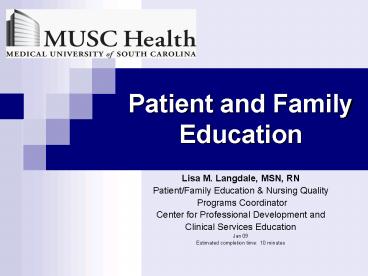Patient and Family Education - PowerPoint PPT Presentation
1 / 26
Title:
Patient and Family Education
Description:
Ginger Kanzer-Lewis RN, BC, EdM, CDE. Failure to Meet Goals. Results in: ... Patient Safety (Lewis Blackman Act, MET team, Medication Reconciliation) HIPAA ... – PowerPoint PPT presentation
Number of Views:7975
Avg rating:3.0/5.0
Title: Patient and Family Education
1
Patient and Family Education
- Lisa M. Langdale, MSN, RN
- Patient/Family Education Nursing Quality
- Programs Coordinator
- Center for Professional Development and
- Clinical Services Education
- Jan 09
- Estimated completion time 10 minutes
2
Objectives
- Identify the goals of Patient Education
- Describe the process of Patient Education
- Discuss regulatory impact on Patient Education
- Review documentation process
- Identify Patient\Family Education Resources at
MUSC.
3
Goals of Patient Education
- increase patients health literacy skills
- improve patient health outcomes and promote
healthy behaviors - involve the patient and family in care and care
decisions - comply standards from accreditation,
certification and regulatory agencies
4
- Sending a patient home unprepared to take care
of themselves and deal with their safety issues
is unacceptable and legally, morally and
ethically reprehensible. - Ginger Kanzer-Lewis RN, BC, EdM, CDE
5
Failure to Meet Goals
- Results in
- Unnecessary doctor visits
- Increased admissions and LOS
- Neglect to get medications or take as directed
6
Steps to Patient Education
- Ongoing assessment of
- Learning needs
- Learning preferences
- Barriers to Learning
- Readiness to Learn
- Effectiveness of Education
7
Learning Needs
- The Do-Know-Deficit
- What do they have to do?
- What do they need to know in order to do it?
- What do they already know?
8
Learning Preferences
- Written materials
- Verbal discussion
- Video
- Practice
- Demonstration
- Other
9
Learning Barriers
- Reading difficulty
- Writing difficulty
- Language/Cultural
- Cognition
- Religious
- Impaired vision
- Impaired hearing
- Financial
10
Readiness to Learn
- Physical (pain, fatigue, etc.)
- Emotional (anxiety, depression, etc.)
- Lacks motivation
- Unreceptive
11
Teaching Tips
- Sit down to be at eye level with your patient.
- Start with basic information.
- Keep it simple.
- Teach what the learner needs to know.
- Make teaching interactive. Ask questions that
require more than a yes or no answer. - Use teaching aids.
- Include family members/caregivers when possible.
- Ask patient to teach back.
12
CMS and Joint CommissionRegulatory Requirements
- CMS
- Heart Failure
- AMI
- Community Acquired Pneumonia
- The Joint Commission
- Childrens Asthma Care
- Anticoagulation Therapy
- Stroke
- Patient Safety (Lewis Blackman Act, MET team,
Medication Reconciliation) - HIPAA
13
CMS Heart Failure
- Documentation that written discharge instructions
were given to patient and addressed - Activity
- Diet
- Follow up after discharge
- Medications
- Symptoms worsening
- Weight Monitoring
14
MUSC Patient\Family Education Resources
- Interpreter Services
- Bilingual employees/Volunteers
- Pacific Interpreters
15
Resources for Hearing Impaired Patients at MUSC
- Policy A-28 Telephone Access for Persons with
Hearing Impairment - Obtain TDD (Telecommunications Devices for the
Deaf) from - Hospital Communications Call Center, Room 243
North Tower. - Policy A-29 Accommodations for Vision/Hearing
Impaired Patients - Notify Social Worker to arrange for a Sign
Language Interpreter.
16
MUSC Patient\Family Education Resources
- Written Patient Education Materials
- Micromedex (http//micromedex/musc.edu)
- GetWell)Network
- MUHA Policy C-65
- MUSC Patient and Family Education
Websitehttp//www.musc.edu/medcenter/staffToolbox
/index.htm
17
Documentation
- Interdisciplinary Patient/Family Education
Flowsheet - Paper tool
- ClinDoc
- Practice Partner
- Procedural Areas
18
(No Transcript)
19
(No Transcript)
20
(No Transcript)
21
(No Transcript)
22
(No Transcript)
23
GetWell)Network
- GetWell)Network provides patients and
- families with access to
- education
- entertainment
- internet resources
24
GetWell)Network
- Mandatory Pathways automatically sent to
patient based on location, diagnosis or facility
requirement - Welcome
- Hand Hygiene
- Shaken Baby
- Prescriber Pathways selected by the care
provider - Heart Failure
- Asthma Care
25
GetWell)Network
- Care provider able to monitor status of
prescribed education - Print report (with barcode) and include in
medical record - Reinforce video with face-to-face communication
and written materials - Complete documentation in ClinDoc
26
Congratulations!
- You have completed this lesson. Please complete
the test now.

